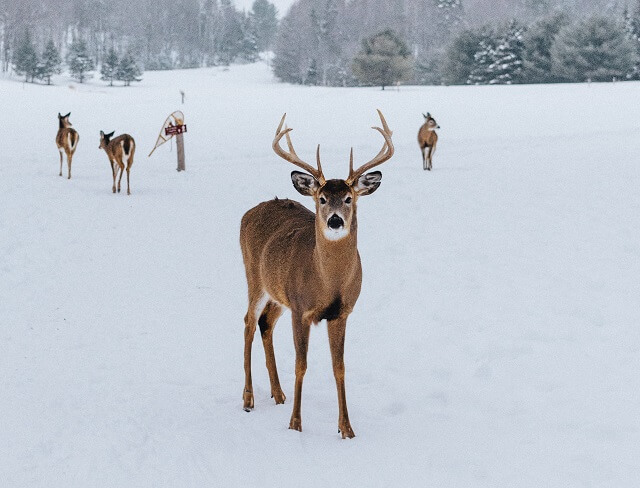
Fishing and Hunting in Gaylord, MI
The Gaylord area boasts countless hunting and fishing opportunities. From the clean, clear waters of our many lakes, rivers, and streams to the thickly wooded inland forests, the Northern Lower Peninsula is the ideal homebase for anglers and hunters alike.
Fishing
By now you’re aware that Otsego County is truly a water wonderland, with over 90 inland lakes and the headwaters of five major rivers. Along with being an outstanding destination for recreational water sports, our waterways are also an angler’s dream come true. Welcome to the heart of “Fishigan.”
Full of “hot spots,” Otsego Lake is on the radar for serious anglers. Known for producing sturgeon, which can grow over 7 feet long and weigh up to 200 pounds, the county’s largest lake will not disappoint. While you might not reel in a trophy sturgeon every time, the water is alive with pike, perch, walleye, crappie, and bass. And ice fishermen find Otsego Lake a great place to shanty up when the ice grows thick in the heart of Michigan’s winter. If you haven’t fished the lakes within the Pigeon River Country State Forest, it needs to go on your to-do list. Many lakes are stocked annually, making trout fishing excellent. Be aware, however, you may encounter boating and bait restrictions. The reward is well worth it, though, and you’ll find yourself not only in a fisherman’s paradise but one of the loveliest natural areas in northern Michigan.

Get Your Gear & Guide
Before dropping your line, visit Jay’s Sporting Goods just south of downtown Gaylord. With a huge selection of fishing rods and gear, bait, knowledgeable staff, and all things fishing at your fingertips, you’ll have the right equipment for an evening or week-long excursion on your favorite lake.
White Pine Guide Service provides professional knowledge on the rivers of Northern Michigan. US Coast Guard Captain Dakota Mack has years of guiding experience ranging from Alaska to Patagonia.Teaching both fly and light tackle fishing methods for Trout, Steelhead and Salmon are his specialty. Located in Walloon Lake MI, Dakota will pick a river within Northern Michigan that will provide the best experience.
Fishing Resources
For information on public access sites and fishing in Otsego County, use the Printable Guide to Fishing in the Gaylord/Otsego County Area. Also, visit the DNR website for seasons, license requirements, and free fishing weekend information.
Check out these helpful pages:
Michigan Trout Trails
Sure, Gaylord’s got loads of fantastic fishing lakes, but did you know the area is stocked with a heap of streams chock full of the north’s famous trout?
Headwaters for the Black, Sturgeon, Pigeon, Manistee, and AuSable Rivers can all be found within our county lines. The Michigan Trout Trails website details biologist-verified trout waters that are often lesser known. Along with detailed descriptions and photos of each site, this DNR-created page lists trout species available, regulations, and many other noteworthy insights.

Your Hunting Hotspot
Otsego County has the well-deserved reputation as a hunting hotspot. Our central location, abundance of state land, active DNR Office, and well-informed local merchants will only enhance your experience.
Throughout the 106,000 acres of the Pigeon River Country State Forest, it’s common for hunters to set up backcountry camps of surplus army tents heated by homemade wood stoves. It can be rough going, but this is how some groups have enjoyed the Pigeon Forest since the days of black-and-white photography, and they wouldn’t have it any other way. Whitetail deer, small game, ducks, and geese are popular game, and acre upon acre of state land leaves room for everyone. Be sure to check with the DNR office for seasonal information and regulations before heading out.

Hunting
Safety & Information
Hunting seasons run from September all the way to March. Even if you are not hunting, it’s a good idea to wear blaze (hunter) orange or other brightly colored clothing while in the woods to make yourself seen where hunters may be present. Dogs should also wear a collar and bright bandanna or handkerchief for their safety.
The DNR website lists expectations of hunters during firearm hunting seasons.
Resources
Check out these helpful pages for more information:



